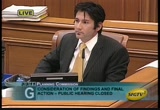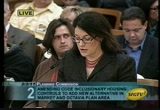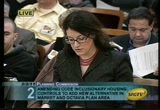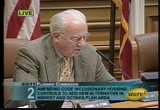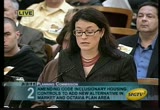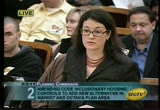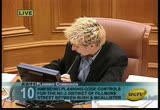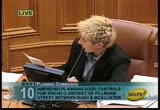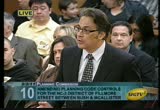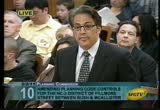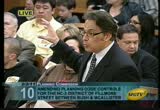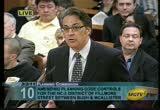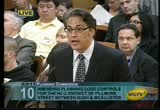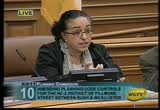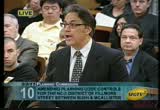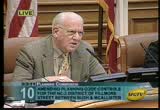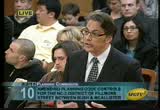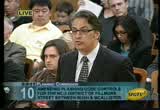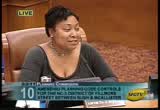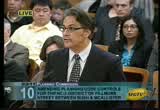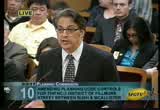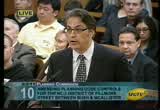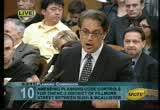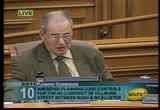tv [untitled] March 3, 2011 2:30pm-3:00pm PST
2:30 pm
and contact information to make sure they get a copy of that. >> thank you. we'll be moving back to item number 2 that was on the consent calendar and this is case 2011.0105 amending the planning code inclusionary -- that's not the one. case 2011.0021 is the large source hotel annual inventory, item five. >> good afternoon. there is a revised inventory that the commission secretary will be passing out to you. and this item in front of you is the annual large tourist hotel inventory that is required by the administrative code for this
2:31 pm
commission to adopt. just to refresh your memory t board of supervisors passed this large tourist hotel conversion in march of 2008 and what it essentially did was establish a one-time 500-room credit for hotel units to be converted into residential units. at that time the former zoning administrator had established a queue which consisted of four hotels. that queue had not change and they had until november 1, 2010 to obtain the first entitlement document from the planning commission in order to continue. all of those requirements were established in the administrative code. the four items that were in the que queue, none of them received their entitlement documents prior to neighborhood first and there is currently no tourist conversion queue. the only way that new unit can
2:32 pm
be established is if there is an annual increase throughout the city of 100 units. there is 100 units and this commission can have a hearing an allot 100 units for conversion. in terms of the overall inventory of the hotel room, we found that it had not changed since they adopted 2010 inventory. the reason you have a new inventory list is that the list that was originally submitted in your packets included an additional hotel that was removed from in 2009 and 2010. so i want to confirm that the total number of hotel rooms in the city currentry are 27,926 and we have not seen any increase or decrease and we are recommending you adopt the motion in front of you to verify the number for the 2010-2011 hotel inventory. i am here for questions. thank you. president olague: thank you. is there any public comment on this?
2:33 pm
. . . >> sue hester for hotel workers and we support the adoption of this motion. thank you. president olague: thank you. is there any additional public comment? seeing none, public comment is closed. commissioner antonini. commissioner antonini: i have a couple of questions. and while this is not, of course, all that is before us is approval of the inventory, not the issue regarding the conversions. but it just seemed a little curious to me that there was this, if you will, grandfathered provision where you would have been able to have converted up to 550 large tourist hotel rooms and done so in a timely manner and now since that's expired it sounds like in order to have conversions as the current law is, you have to have the establishment and equal number
2:34 pm
of hotel rooms, if i am reading this correctly. >> the administrative code you are somewhat correct. the administrative code only allows for that one-time 550 allotment. that has gone. and the way the administrative code reads is it that's on a 100 room basis and if we have 100 rooms put into the city that meet that deaf situation, you can have a hearing and an allot 100 rooms. if there is a desire to establish another large queue such as another 550-room conversion, that would have to
2:35 pm
be legislated back into the administrative code. and currently that was the way it was set up. when the board passed the ordinance, they recognized there were projects in the pipeline that were going to convert and they allowed a two to three-year window for them to attempt and try to go through this process. as i outlined in the case report, they did not pursue it and two were unable to get the
2:36 pm
intieltment and they basically de-- to get the entitlement and they basically defaulted. commissioner antonini: i guess my question is that the feeling is 28,000 was number of hotel rooms we needed but we could live with 500 less and now since the time is expired and i guess we can't live with 500 less and it seems like if it was good then, it should be good now and never should have been good. i am not quite sure and i guess it has to do with grandfathering and that was probably the idea why it was in there and it was felt we can't lose any large hotel room. >> honestly w the policy call done at the board of supervisors, they felt that was sufficient and that that is sufficient. we want to increase hotel rooms. commissioner antonini: right. we actually prefer to have more rather than less. i think i understand. it's just a little confusing. thank you. president olague: is there a motion? >> move to adopt. secretary: on the motion to adopt the large tourist hotel annual. [roll call vote] >> thank you, commissioners. that item has been approved. and now we will turn back to what appears to be the first item on the regular calendar, item 10, case 2011.0046t.
2:37 pm
this is the ordinance to amend the planning control for the n.c. 3 district between bush and mcalester street and it is board of supervisors file 11-0010. and commissioners, i am staffing this item and i'm anmarie rodgers from the planning commission and i will present this ordinance to you. and this ordinance was introduced by as a targeted piece of legislation which would require active ground floor commercial uses on fillmore street and between bush and mcal allister and i believe we will have a speaker shortly to describe the impetus for the particular ordinance. while we're waiting for him, i'm describe the ordinance previously. and the ordinance would amend the active use section of the planning code which was many active uses and requires in certain areas of the city. if approved, this ordinance would acquire the uses on fillmore street between bush and mcallister. and this does exclude and therefore would prohibit other uses on this list. and including office uses, and that individual uses 25 feet into the building. if there were uses of larger than that, it need to be wrapped along the frontage so the uses were in front of it along the sidewalk. commissioners, in reviewing this particular ordinance, the department recommends approval with a small modification.
2:38 pm
and we would modify the active uses as defined and currently in the planning code to include a couple of other uses. the first we recommend should inexclusive self-service specialty food restaurants and that is a new restaurant definition that did not exist when the active uses were originally defined and probably should have been included in this list when it came into existence. and similarly outdoor activity areas should be included in the list as they go a long way in creating active spaces along the sidewalk. and there we have the esteemed supervisor and his aid and we just described the ordinance and if you would like to take a moment to describe the purpose of the ordinance. president olague: and also want to acknowledge tom from the city and i know you have been worked on this extensively. okay. >> no special privilevileges to.
2:39 pm
>> hi. honorable commissioners, thank you very much, and i'm representing district five and thank you very much to the planning department for our assistance in drafting this legislation. i'll give you the high-level reason why i put this in there and make personal motivation and the fillmore in the western area in japantown was under the rubric of the redevelopment agency for approximately 45 years. and the redevelopment tenure of the fillmore and the western edition terminated in january 2009. arguably, there were high points and in my opinion many low points of the experience of urban renewal in that particular area. and one of the them was because of the land use and zoning decisions that have been made
2:40 pm
along the fillmore corridor throughout the western addition were not consistent with the city's planning code and the desire of how the city's planning code and land use and zoning conditions had evolved over the decades. as a consequence like in the fillmore corridor, you would see practices like in the fillmore that wouldn't have been tolerated or aloud or encouraged anywhere else in san francisco. and one of the reasons why i think that an area like the fillmore in the western edition i think was underresourced and somewhat subverted in the ability to decide for themselves because, again, they were under a different governance of land use for the large part being redeveloped. and one of those consequences was that in the corridor of fillmore, south of -- or south opposed to gary, moving through the western edition, you could have a store front, retail in
2:41 pm
the mixed use and commercial corridor where you can put an office right there in there. now, one would think in a commercial corridor like ours you would have some kind of retail space, restaurants, place to dine perhaps, place to shop. on the east side of the fillmore corridor, we had that. on the west side of the fillmore corridor for many blocks we do not. because the property owner who decided that they wanted to lend it out and lease it out to the social security office which had it for many years or to a clinic which is fine, clinics being there and they want to be there and what they were doing, in my opinion, playing with who could pay the kind of dollar they were looking for and subverting the potential of there being more
2:42 pm
vibrant retail access in that particular area. and so right now especially since the waning days of redevelopment and since january 2009, there has been a vigorous effort to get more business in the fillmore corridor south of gary and it's coming. and i do not want to see the businesses that my office and the office of economic work force development and others who are hunting and trying to recruit to come down to have this very lopsided, uneven kind of total quality when people are there to shop and to dine and all of a sudden they're walking
2:43 pm
past two or three swatches of blocks and it's office space. it makes no sense. in union square there is no way we would tolerate this. if there was some store front retail and they go out of business and i don't think necessarily it would comport with the retail unity and business community of union square that the immediate reflex would be, well, we need to certainly get that building leased and occupied and we don't want it to be boarded up so let's turn it into an office p unheard of. so why would we do that to a
2:44 pm
neighborhood merchant corridor, especially one that is struggling to return a flavor that makes it a cultural destination site. so i have done similar things and we have things like the sodero and the comeback kid story and great things have happened. so why less than a mile away, less than a mile, maybe half a mile, would we not provide that same right to the fillmore as we would to union square and others? and that is before you our legislation. and it is more perspective not to evict anybody that is now but should there be that turnover, in the future of those offices and that no longer have the releases -- or the leases are coming up for expiration, and we turn back, excuse me, to a retail purposes and restaurant purposes. and there's only several vacancies right now that are on the west side. and we are very happy to report that they are now being slated to be restarting this summer and early fall. and so very few remain and the ones that are going to be nonretail in the three block areas are the very buildings that are the impact question of this ordinance. so be more than happy to answer any questions. president olague: thank you. i know a couple of commissioners have their names up so i'm going to do that before going to public comment or? any questions? >> commissioner, i would like to expand on the point supervisor mirkairmi stated in "the chronicle" that said businesses would be evicted when the leases expire and as you know that is
2:45 pm
not correct. land use entitlements are granted not to individual businesses but the property at hand. if the property has an entitlement for office use and they are exchanging to another office use, they could do so if they dent need to expand or do any intensification. and so it would make the office uses nonconforming and we would like to see them convert, but nobody would be forcibly evicted with the adoption of this ordinance. president olague: thank you for clarifying that. i spend a lot of time walking along that block because i live in the vicinity and there is a need to be revitalization and many ways what that area has the seen. one of the concerns i had is the number of formula retailers in that block. so is there mowd engaged or i
2:46 pm
don't know who is engaged to the top and local business people? if you don't mind. >> that is another gift of urban renewal. in a redevelopment jurisdiction, there were no formula retail restrictions. so in the fillmore corridor, we have the highest concentration of fast food restaurants because it was encouraged as the enterprise and strategy by the redevelopment agency throughout the 70's and 80's to let them land there and in a one or two block radius i will have an mcdonald, a domino's pizza, a panda express, a subway station, a subway sandwich shop and others within a two-block radius because the goal wasn't necessarily using a mom and pop, but it was bringing in that retail experience in my opinion and it was very short sighted.
2:47 pm
we are living with the consequences of that. my response to that now is restrict from that happening and i know that might cause consternation with people who think you are not supposed to mess with capitalism, but it is completely undermines the global economy for people who live in the area and want to invest in the area and stays and we tried it for 45 years under redevelopment. and now let's try it a little differently as we would in another neighborhood and i can show you where the successes have worked and nearby and it's also north of gary on fillmore and that is the upper fillmore and the mid to upper fillmore corridor. they're not treated the same way as the mid to lower fillmore is because redevelopment jurisdiction stopped at suter. and so when suter and fillmore south, you can see the compl marketable difference of what land use zoning contrasts were in that area. and it's between gary and suter
2:48 pm
on fillmore that you have been able to intervene but it makes you wonder then if you can see the fast food infusion to burger king was right there and so you can see the happenstance way the planning had occur and now it is time to bring former redevelopment corridor to the largest former redevelopment tract up to continuity with san francisco planning code. the first step in doing so is this ordinance. president olague: thank you for your work on this. >> thank you. pleasure. president olague: any other questions from the supervisors -- >> didn't i see you in the burger king the other day? >> with a plastic bag. commissioner miguel: supervisor,
2:49 pm
thank you for coming. appreciate what you are doing on this. i had a question about some of the uses that would be prohibited. i know on west porthole we have ground level medical and dental uses and other type of uses and we have and i would assume that financial would be categorized separately from office. is that correct? >> financial being? >> banks or other financial institutions. >> so they're fine. and there are some where you do have some selective medical uses and i know a movie theater would be disallowed which i am not sure anyone is going to go and put a movie theater but it might not be the worst use. >> are you kidding? i encourage that, but that would be over -- >> yeah, it was listed as a number of things that would be prohibited. but not limited to. >> not prohibited. >> maybe my paperwork is not accurate. but noticed that one.
2:50 pm
board boa commissioner borden: i think this is spot on and most people stop at gary and turn around and don't continue down the street and farmers' market is a huge success. and i know you have been working with urban solutions and one of the things they go do is focus on the fillmore and have you talked to them about the legislation and how it might be helpful? >> i talked to them about four years ago as i was gearing up for the conclusion of the redevelopment era on fillmore because i have been used that pulpit in my office to draw attention to the fact that recently with the lead and commissioner sugaya was there in japantown to show the connection and the disconnection of what gary boulevard did to segregate western addition fillmore from ja pantown and i think that it is the proper term to call ate
2:51 pm
berlin wall and we would talk to urban organizations and to knit back the vitality that was once shared both communities and the japanese community and the african-american and the working class community were very strong in the 1post 40's after what ha been done to the japanese community. but had been refortified for some years until redevelopment subverted and now we're looking for ways to bring that together. so it's incremental. in fact, there is a corner building where the japantown bowl used to be at 1600 western. another travesty that reminds us every day that it was replaced with 42 condo units, not really affordable, and decimated the japantown and it's always remained vacant since that building has been established because the redevelopmental law allowed that to be vacant. it is retail and remained vacant since the 42 units were
2:52 pm
developed and it is an insult to the japantown community and the rest of san francisco and there's never been a compelling authority that has made sure that that space be occupied because we don't have that kind of vacancy law to do so. that was another gift of urban renewal gone wrong. and so we are trying to line this up between fillmore and upper fillmore and into japantown and throughout the western edition to modernize land use so it is more in sync with planning code. commissioner borden: i think this is great and to ask you guys to work on a credit union or a bank in that area and the check cashing place but not a lot of real banking options for the vimmings in that area -- for the individuals in that area. it is unfortunate because people
2:53 pm
would over utilize the check cashing services. >> i completely agree to commissioner antonini that i would rather put a credit union, but to afford in san francisco is agencies that are held responsible and were in poor communities is i don't care what kind of economic infusion. and give them more cash checking places, give them more fast food restaurants, give them more chain stores in this regard and while that may look good on the front lines because something is seen as being established, it purports to be hiring people locally or whatever the case is, but in the long run it does not have that kind of benefit back into the community. and there is a lavatory that proves this and that is in the western edition. commissioner borden: i am 100% supportive and think this will go a long way in having a more active business community and
2:54 pm
the challenge with up thor fillmore and one of the reasons they have fought against formula retail to engage the stores in the local community in participating in the different street walks and events and we look forward to being able to support bringing that area back. >> it's all about balance. president olague: commissioner moore. commissioner moore: supervisor, and as this becomes a model for redevelopment proceeding in other areas and this paves the way for us to re-examine how to heterofit. the problem i'm wondering if that was done for you and redevelopment brought with it oversized buildings and necessarily don't replicate or implicate the surrounding development and created massive renewal without the contractual sensitivity and in some cases the ground floor created oversized spaces which were smaller retail or inappropriate and i hope the spaces which we are now rezoning for different kinds of uses have the architectural ability to be subdividable and that smaller entrepreneurial retail can indeed have a successful business and i hope that the
2:55 pm
people who helped you look at those buildings and that indeed will effect to target the smaller neighborhood retail which we are interested in to create that bridge on the other side of fillmore. >> right. the answer is yes, but i don't have a conclusion because there is no master plan in dealing with it. and i suggested to the predecessors in anticipation of redevelopment exit, i think there should have been an area wide plan of japantown and of the western addition. there was literally no exit plan and you almost have to treat it like when the military base closures occurred throughout the united states during the and after the clinton administration and local governments and regional governments were preparing for that sort of evacuation of property before it was transferred back to local and regional government. we never did that here. so we're now not only trying to address these things block by block, and codes need to unite between sdi code and what was -- between city code and what was
2:56 pm
under redevelopment's prism and preparing for the business model of enterprising people who might get a leg up in a corridor like the fillmore. but there is literally no plan for that at all. commissioner moore: and i am particularly interested in hearing you speak to that because we are in the middle of re-establishing new redevelopment projects of rather significant size and finding the balance between redevelopment and proper city governance that is for me the big question mark because we're still operating and moving into the future and looking at two forms of governance. >> well, to me to be honest with you're welcome and this is the conversation i would dig getting into but would take a long time, but quite frankly, other than the redevelopment agency commission having this discussion -- >> i think we need to other.
2:57 pm
>> is a real miss that it's not being heard in city hall because we often have parallel government and with all the -- i think with all the effort by governor brown and others in the metmore sis or is elimination, nobody is talk about reform except director blackwell is trying but try to envision levels of reform that were at the policy juncture and perhaps influencing right now. having that is difficult. and i would, for example, say god forbid how it should be an infrastructure like this. and that is just a side note. it would be a step in the right direction. i have more faith in the bayview project area of redevelopment that will be wise enough to not make some of the mistakes they did in the fillmore and japantown and hoping it will be wise enough to think three to four decades ahead that you have an exit plan in knowing what it means to have the areawide government system by a two-year
2:58 pm
municipal government system. what most realize is that the foilmore was -- the fillmore was occupied in a completely different land use model than the rest of san francisco for all those years. people in the western addition had no idea and would be implementing at city hall and city hall would say we're handcuffed because redevelopment agency goes through state law and they couldn't understand why they couldn't get redevelopment response. that is a whole new sort of organizing tactic for people to understand how to access local government and not just to assess the planning and go to redevelopment and do it there, too. >> commissioner miguel? commissioner miguel: i am appreciative of what you were
2:59 pm
talking about and the gas club venues that i was used to started in the late 50's and 60's to disappear and they were not replaced by any active situation bd to an extent they were the late afternoon and nighttime and weekend part of the district basically where i learned jazz and some of the indication of the willingness of people to get rid of the situation that you are trying to get rid of has been the only in the last several years that the fillmore street annual jazz festival has extended past gary.
80 Views
IN COLLECTIONS
SFGTV2: San Francisco Government Television Television Archive
Television Archive  Television Archive News Search Service
Television Archive News Search Service 
Uploaded by TV Archive on

 Live Music Archive
Live Music Archive Librivox Free Audio
Librivox Free Audio Metropolitan Museum
Metropolitan Museum Cleveland Museum of Art
Cleveland Museum of Art Internet Arcade
Internet Arcade Console Living Room
Console Living Room Books to Borrow
Books to Borrow Open Library
Open Library TV News
TV News Understanding 9/11
Understanding 9/11